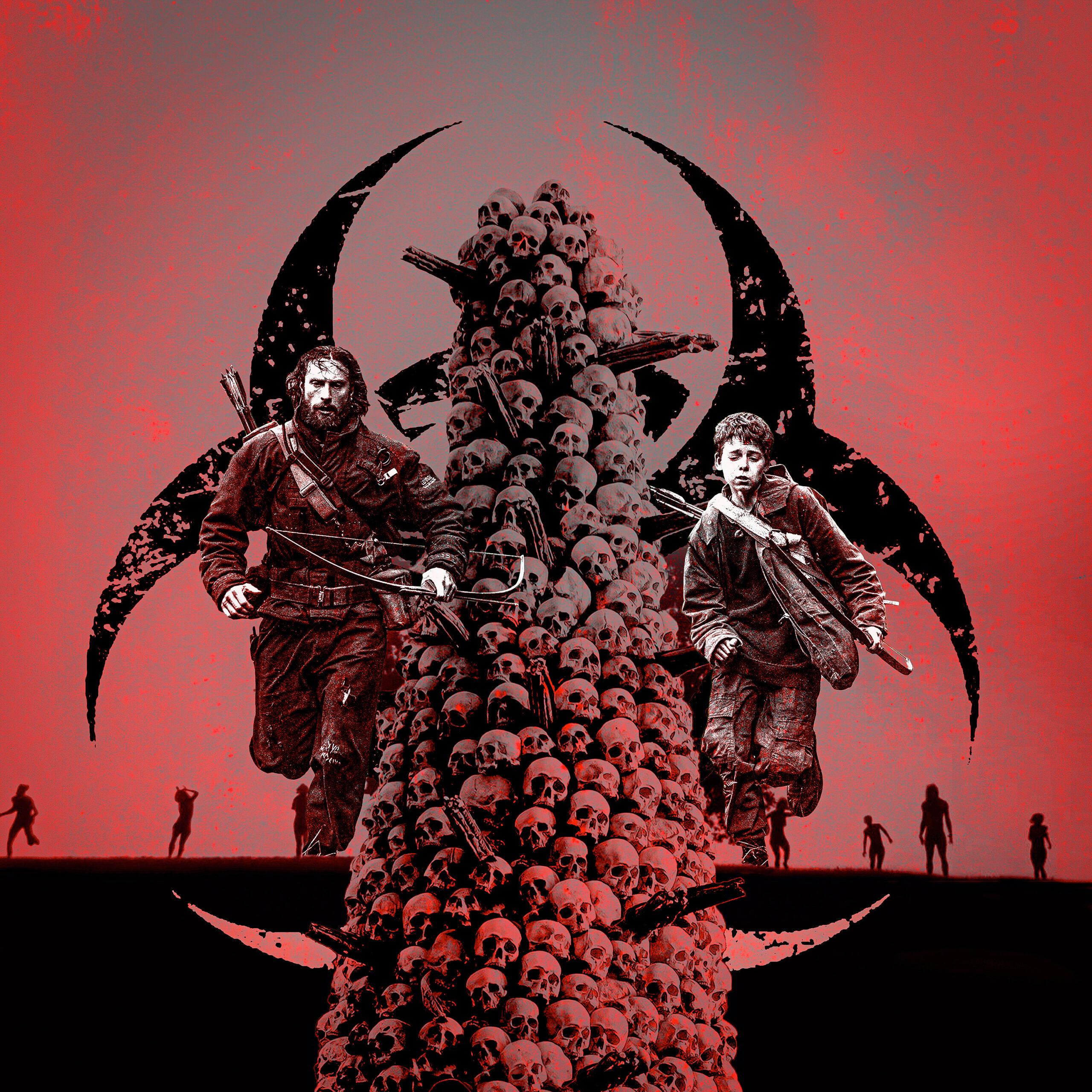
In 2002, 28 Days Later helped revitalize zombie movies. The postapocalyptic horror film centered on the outbreak of a highly contagious infection—known as the “rage virus”—that led to the collapse of society in the United Kingdom. Directed by Danny Boyle and written by Alex Garland, 28 Days Later was grounded in realism, both in its visual style and its world-building, and served as a character-driven drama that didn’t prioritize its thrills over substance. And now, more than 20 years later, Boyle and Garland are reuniting to revive the dormant film franchise with a new sequel: 28 Years Later.
After the surprise success of the original, the follow-up 28 Weeks Later arrived in 2007. However, the film featured a new creative team. Boyle, who was busy working on 2007’s Sunshine, remained as an executive producer but was replaced at the helm by Juan Carlos Fresnadillo. Garland was likewise preoccupied as the writer of Sunshine, and so 28 Weeks Later also featured a new group of scribes: Rowan Joffé, Enrique López Lavigne, Jesus Olmo, and Fresnadillo. With 28 Years Later, Boyle and Garland are returning to their deteriorating world of infected for their own sequel, equipped with a fresh, star-studded cast that will help kick off a new film trilogy.
28 Years Later, which stars Jodie Comer, Aaron Taylor-Johnson, and Ralph Fiennes, arrives in theaters later this week, and its successor, 28 Years Later: The Bone Temple, is already set for release in January 2026. The Bone Temple, directed by Nia DaCosta, was shot back-to-back with its predecessor, which explains this incredibly fast turnaround.
It’s been a long time since audiences have been treated to a film in this cinematic universe. And now that we’ll be getting two of them in the span of just six months, a refresher is in order. Ahead of 28 Years Later, here’s everything you need to know about the film franchise and where it’s headed.
28 Days Later
28 Days Later is one of the most influential horror movies of the 21st century, particularly in the realm of zombies. The 2002 film, which cost a reported $8 million to produce, was partially shot on a camcorder (the Canon XL-1), giving it the distinctive visual feel of a home video, which accentuates the grounded nature of the filmmaking. And, crucially, 28 Days Later popularized fast-moving zombies within the genre, as the film’s infected would sprint toward their intended prey at alarming speeds rather than shuffling around at a glacial pace. It wasn’t the first movie to feature fast zombies, but its terrifying take on the horror staple helped usher in a new wave of TV shows and films that were inspired by its radical disruption of the status quo.
But let’s take a step back to recap what this film is all about.
28 Days Later begins by showing the origins of the so-called rage virus and how it started to spread across the U.K. A trio of animal rights activists breaks into a research facility that contains chimpanzees who have been infected with “rage,” as a startled scientist explains to the intruders. The scientist warns that the chimps are highly contagious, and that one bite from any of them could spread the virus within their blood and saliva. Of course, the misguided activists completely ignore him. When one of them frees a chimp from its cage, the infected animal races toward her to bite her, commencing the domino effect that quickly results in the virus spreading to everyone in the room—and soon, to others outside of it.
The main story picks up 28 days after the initial outbreak, as it follows a bike courier named Jim, played by Cillian Murphy in the actor’s breakout role. After falling into a coma after a bike accident before the outbreak, Jim wakes up in a deserted hospital, and suddenly finds himself in a version of London that appears to be devoid of all life—until it isn’t. After initially being saved from an infected horde by two survivors, Selena (Naomie Harris) and Mark (Noah Huntley), Jim later survives another infected encounter and, along with Selena, eventually joins forces with a former cab driver named Frank (Brendan Gleeson) and his young daughter, Hannah (Megan Burns). Together, the four of them drive out of the decaying city toward a military encampment, where Major Henry West (Christopher Eccleston) is promising salvation for humanity.
By the end of the film, Jim, Selena, and Hannah are still searching for refuge from the infected. Their trip to the military encampment not only resulted in Frank’s untimely death, but it led them to a group of desperate, depraved soldiers who sought to exploit Selena and the teenage Hannah as their sex slaves so they could start to repopulate society. (In order to get the group out of this disturbing predicament, Jim goes full Rambo to save his traveling companions, and a drugged Hannah sacrifices West to an infected soldier so they can all escape.) 28 Days Later concludes with another 28-day passage of time after Jim and Co. have relocated to a remote cottage, where the three survivors attempt to display a distress signal—a massive cloth tapestry that spells out “HELLO”—to a jet that periodically flies above them.
When the end credits roll, it isn’t clear whether the jet has spotted them—but there’s a glimmer of hope that it has. The film also shows a number of infected lying on the roads near their cottage, slowly dying of starvation. 28 Days Later leaves the fate of the survivors—and the infected—unknown, yet it still shows signs of more life elsewhere in the U.K.
Throughout the film, the lack of information that the audience receives about the world creates an intriguing tension as viewers—much like Jim and his friends—are left to question how far the infection has spread across Great Britain, or even beyond it. And that mystery was one of the main questions that 28 Weeks Later sought to explore.
28 Weeks Later
The 2007 sequel featured not only a new filmmaking team but also a new cast and almost twice the production budget at $15 million. And yet 28 Weeks Later didn’t tap into the same creative—and, at times, chaotic—energy that made its predecessor such a singular and influential entry in the horror genre. Despite the greater budget, the film earned less at the box office, finishing with a global tally of $65 million, compared to the original’s $72.6 million (excluding the additional ticket sales from the film’s rereleases).
28 Weeks Later is a worthy sequel all the same. Fresnadillo’s follow-up widens the scope of the postapocalyptic world as an American-led NATO force takes control of the reconstruction of Great Britain. More so than the original film, 28 Weeks Later explicitly states the circumstances surrounding the outbreak of the rage virus and how the British government responds to it.
Twenty-eight weeks after the outbreak, Britain has already begun to repopulate. The island had been declared free of the infection, with the last of the infected believed to have died from starvation several weeks earlier. But as the events of the film quickly prove, the NATO forces begin to rebuild society too hastily, which ultimately leads to a second outbreak that has even more dire consequences.
28 Weeks Later largely follows a family that gets separated during the initial outbreak, with Don (Robert Carlyle) and his wife, Alice (Catherine McCormack), starting the film in a remote cottage outside of London while their daughter, Tammy (Imogen Poots), and son, Andy (Mackintosh Muggleton), are out of the country. When their group gets attacked by an infected horde, Don leaves Alice behind to die as he takes a boat to safety. He reunites with his children back in District One, where London is being repopulated on the Isle of Dogs, but it doesn’t take long for Tammy and Andy to sneak out of their newfound sanctuary to return to their home to grab some of their old possessions. And while they’re there, they discover that their mother is still alive—though she is very unwell.
Alice and her kids are brought back to District One, where a medical officer named Scarlet (Rose Byrne) discovers that Alice is infected with the rage virus, despite not showing the common symptoms that typically end with the host gouging out the eyes of anyone in sight. Scarlet determines that Alice has a rare immunity to the infection, one that could potentially be used to develop a cure for the virus. But the U.S. general in charge, Stone (Idris Elba), decides that it’s safer for Alice to be killed and for her corpse to be studied thereafter.
However, before any of that can happen, Don sneaks in a visit to his quarantined wife to apologize for, uh, leaving her to die that one time. And when Don foolishly kisses Alice, her saliva passes her infection to Don and causes the second outbreak of the rage virus.
At the end of the film, Andy gets infected as well, but he shares the same genetic immunity to the virus and shows none of the disastrous symptoms that come with it. When he and Tammy are saved, Tammy keeps her brother’s infection a secret as their rescue helicopter heads to France. 28 Weeks Later never shows their fate either, but the story ends with a new horde of infected sprinting toward the Eiffel Tower, confirming that the virus has spread beyond Great Britain.
Although 28 Years Later will be the third entry in the 28 Days Later franchise, Boyle has been pretty candid about how little his upcoming film will have to do with the events of 28 Weeks Later.
“What was unique about the first film and was the best choice we ever made about it was that it featured entirely British,” Boyle told Collider. “It was just that land. And it was extraordinary thinking about something that powerful breaking out in that particular space, and it had to be dealt with by the inhabitants of that land. And we decided to concentrate on that. There’s nothing wrong with 28 Weeks Later. We just decided not to follow those story elements. And it’s a bold choice we decided to declare up front by saying the rage virus was driven back from mainland Europe.”
You might think that something as crucial to the world-building of this cinematic universe as an immunity to the rage virus would at least carry over to the new trilogy, but when Collider asked Boyle whether that plot point would be explored at all in 28 Years Later, he simply replied, “No.” It seems like an odd choice to all but ignore 28 Weeks Later altogether, but it also makes sense given Boyle’s—and Garland’s—relative lack of involvement in its creative direction. Now that Boyle and Garland are back to lead the film franchise into a new era, the creative duo is bringing it back to its roots and focusing more on the world they originally introduced in 28 Days Later.
28 Years Later … and Beyond
In 28 Weeks Later, it’s revealed that all the infected (supposedly) died from starvation within a matter of weeks after the outbreak. With that in mind, it’s hard to imagine that the rage virus would still be around after 28 years, particularly if it was “driven back from mainland Europe,” as Boyle described. But as the filmmaker elaborated to Collider, the virus adapted over time.
“It’s obvious to talk about the survivors and how they survived,” Boyle said. “But the less obvious thing is to talk about the virus and how it survives. It survives because it decides the enormous energy that’s extended in the infected, that you see in the first film, would burn people out? The calorie consumption would be enormous, and it would burn people out. So, they’ve got to learn … they are going to die out or evolve. So they learn to hunt.”
28 Years Later will bring audiences back to this postapocalyptic world to reveal how it, too, has learned to adapt to life after the virus. Like 28 Weeks Later before it, the upcoming film will feature a new cast, with Comer, Taylor-Johnson, and Fiennes headlining. But Boyle has also confirmed that Murphy—who returns as an executive producer on 28 Years Later—will be reprising his role as Jim for a small role in DaCosta’s The Bone Temple, and for a “very dominant” part in the untitled fifth film of the series. Although Sony Pictures has yet to officially confirm the final entry of this new trilogy, Boyle has committed to returning as its director, while Garland has already written the script.
With a reported budget of $75 million, 28 Years Later was pricier than its predecessors, by a wide margin. However, that cost is still modest compared to other modern blockbusters; this summer’s Jurassic World Rebirth cost more than double that, at a reported $180 million. And not unlike the original film’s inventive usage of camcorders for the filming process, 28 Years Later will follow the recent filmmaking trend of utilizing a smartphone as its camera of choice, becoming the biggest release yet to be shot primarily on an iPhone.
Given how much time has passed since 28 Days Later, it remains to be seen whether 28 Years Later will be able to recapture the magic of the original film, or whether it will prove to be yet another desperate, misbegotten attempt to recycle an old film franchise. As Boyle told Letterboxd in a recent interview, Garland’s original idea for the new movie was a more predictable concept for a sequel that would have involved world governments seeking to weaponize the rage virus. But then the screenwriter took it in another direction, one the filmmakers now hope can resonate with audiences the same way that 28 Days Later did, all those years ago.
“He started to think about a much bigger idea, and an idea of three films, which would each be independent of the first film, 28 Days Later,” Boyle explained. “... They would have elements within [them] that connected them and that the storytelling is ambitious and outrageous in many ways. And you try to be as original as the first film was when it came out. And therefore, you hope that in 20 years’ time, they’ll still be showing these films at all and people will still be enjoying them.”

